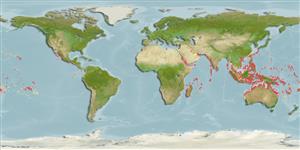Common names from other countries
Environment: milieu / climate zone / depth range / distribution range
Ecologia
marino associati a barriera corallina; distribuzione batimetrica 2 - 25 m (Ref. 90102). Tropical; 30°N - 30°S
Indo-Pacific.
Size / Peso / Age
Maturity: Lm ? range ? - ? cm
Max length : 29.0 cm TL maschio/sesso non determinato; (Ref. 30573); common length : 18.0 cm TL maschio/sesso non determinato; (Ref. 30573)
Spine dorsali (totale): 5; Raggi dorsali molli (totale): 21-22; Spine anali 1; Raggi anali molli: 17 - 18. Easily identified by the large black blotch on the tail. Body and head spotted, except in large males that feature lines on the cheek instead (Ref. 48636). Upper third of body greenish to brownish grey, flecked with dark brown, the lower two-thirds white with 3 or 4 longitudinal rows of small dark brown spots, sometimes linked by narrow dark stripes except lower row as discrete yellow-edged black spots. Caudal fin with a very large black spot centrobasally in fin. Last membrane of spinous portion of dorsal fin connected to first dorsal-fin ray nearly at height of fifth dorsal-fin spine (Ref 42740).
Found on sand and rubble bottoms of shallow lagoon and protected seaward reefs (Ref. 9710, 48636). Also Ref. 58652.
Life cycle and mating behavior
Maturità | Riproduzione | Deposizione | Uova | Fecundity | Larve
Randall, J.E., G.R. Allen and R.C. Steene, 1990. Fishes of the Great Barrier Reef and Coral Sea. University of Hawaii Press, Honolulu, Hawaii. 506 p. (Ref. 2334)
IUCN Red List Status (Ref. 130435)
CITES (Ref. 128078)
Not Evaluated
Threat to humans
Harmless
Human uses
Pesca: scarso interesse commerciale; Acquario: Commerciale
Informazioni ulteriori
Nomi ComuniSinonimiMetabolismoPredatoriEcotossicologiaRiproduzioneMaturitàDeposizioneFecundityUovaEgg development
BibliografiaAcquacolturaProfilo di acquacolturaVarietàGeneticaElectrophoresesEreditarietàMalattieElaborazioneMass conversion
Strumenti
Special reports
Download XML
Fonti Internet
Estimates based on models
Preferred temperature (Ref.
115969): 24.9 - 29.3, mean 28.3 (based on 3415 cells).
Phylogenetic diversity index (Ref.
82804): PD
50 = 0.5000 [Uniqueness, from 0.5 = low to 2.0 = high].
Bayesian length-weight: a=0.00813 (0.00499 - 0.01323), b=3.11 (2.97 - 3.25), in cm Total Length, based on LWR estimates for this species & Genus-body shape (Ref.
93245).
Trophic level (Ref.
69278): 3.6 ±0.3 se; based on diet studies.
Resilienza (Ref.
120179): Alto, tempo minimo di raddoppiamento della popolazione meno di 15 mesi (K=0.4).
Fishing Vulnerability (Ref.
59153): Low to moderate vulnerability (28 of 100).
